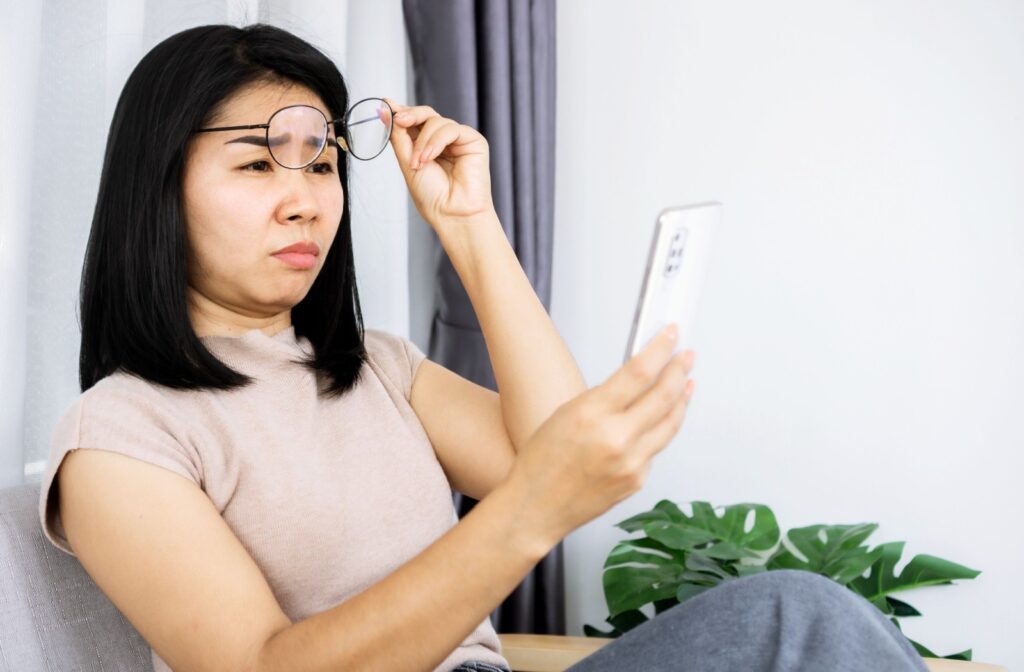As a parent, you pay close attention to your family’s health, and that includes their vision. You might notice your child squinting to see the board at school or complaining of headaches after reading. These small signs can point to common vision conditions that affect how clearly we see the world, highlighting the importance of regular children’s eye exams.
Understanding the difference between them is the first step toward clear, comfortable vision for everyone in your family, which is why we offer comprehensive eye exams for all ages. The key distinction is that nearsightedness (myopia) causes distant objects to appear blurry, while farsightedness (hyperopia) makes close-up objects look out of focus. Each condition happens because of the unique shape of an individual’s eyes.
A Simple Look At How Vision & The Eye Work
Think of your eye as a camera. For you to see a clear picture, light enters the front of your eye through the cornea, which acts like a protective window. The light then passes through your lens, which focuses it onto the retina at the very back of your eye.
The retina is like film in the camera—it captures the image and sends signals to your brain. When the shape of the cornea or the length of the eyeball is just right, light focuses perfectly on the retina. If that focus point is off, even slightly, the image your brain receives becomes blurry.
What Is Nearsightedness (Myopia)?
Nearsightedness, or myopia, is a common condition. If your child is nearsighted, they can see things clearly up close, like a book or a tablet. However, objects far away, like a whiteboard in a classroom or a road sign, appear fuzzy.
This happens when the eyeball is slightly longer than average or the cornea has a steeper curve. As a result, light focuses in front of the retina instead of directly on it.
Myopia often develops during childhood and can progress as your child grows, which is why we offer myopia control to help slow progression of the condition.
Why Distant Objects Look Blurry
When you’re nearsighted, your eye’s focusing power is too strong. The light rays from distant objects converge too soon inside your eye. This means that, by the time light rays reach the retina, they’ve started to spread out again, creating a blurred image.
Signs Of Nearsightedness
- Blurred vision when you look at distant objects
- A need to squint to see things far away
- Headaches or eye strain
- Eye fatigue when you drive or watch sports
What Is Farsightedness (Hyperopia)?
Farsightedness, or hyperopia, is the opposite of nearsightedness. With this condition, you can typically see distant objects well, but things up close are blurry and hard to focus on. This can make activities like reading, writing, or using a computer feel strenuous.
Farsightedness occurs when the eyeball is a bit shorter than normal or the cornea is too flat. This shape causes light from close-up objects to focus at a point behind the retina. Young eyes can sometimes compensate for mild farsightedness, but the extra effort can lead to eye strain and headaches.
Why Close-Up Objects Look Blurry
When you’re farsighted, your eye doesn’t have enough focusing power for its length. To see clearly up close, your eye’s lens must work harder by focusing in order to bend light rays. This constant effort can be tiring for your eye muscles.
Signs Of Farsightedness
- Blurred vision with nearby objects
- A need to squint to see up close
- Eye strain or fatigue when you read or write
- Headaches after you focus on close tasks
Key Differences Between Nearsighted & Farsighted Vision
The easiest way to remember the difference is in the names themselves. If you are nearsighted, your vision is best at a near distance. If you are farsighted, your vision is clearest at a far distance.
Beyond what you find blurry, the physical cause is also a key distinction. Nearsightedness is often due to an eye that is too long, while farsightedness is linked to an eye that is too short. This difference is reflected in your prescription—a minus sign (-) corrects nearsightedness, and a plus sign (+) corrects farsightedness.

Vision Correction For Your Family
Eyeglasses & Contact Lenses
Eyeglasses are a straightforward and popular choice for vision correction for all ages. They work by placing a corrective lens in front of your eye to properly focus light onto the retina. With so many fashionable eyeglass frames available, glasses can also be a fun way to express personal style.
Contact lenses are another great option. Many people prefer contacts for sports or for a glasses-free look. Your optometrist can help you find the right type of contacts for your needs after a thorough contact lens exam.
Refractive Surgery Options
For adults looking for another type of solution, refractive surgery like LASIK is a possibility. These procedures reshape the cornea to permanently change how light focuses on the retina. This can reduce or eliminate the need for glasses or contact lenses for many people.
Deciding if surgery is right for you is a personal choice that involves a detailed surgery consultation. We can discuss all available options to help you make an informed decision. Your long-term eye health is always our main consideration.
Schedule Regular Eye Exams
Vision can change throughout life, especially for growing children, so routine eye exams are an important part of your family’s overall health. Regular check-ups help us track these changes and make sure everyone’s prescription is just right. At Bluebird Vision + Wellness, we take pride in providing comprehensive vision care for your whole family. We are committed to helping you see, look, and feel your best. Contact us today to schedule an appointment and get the clear vision your family deserves.




